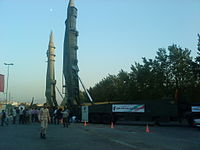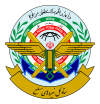Sejjil
| Sejil | |
|---|---|
 | |
| Type | Medium Range Ballistic Missile |
| Place of origin | Iran |
| Service history | |
| In service | In service as of 2014 |
| Used by | Iran |
| Production history | |
| Manufacturer | Iran |
| Specifications | |
| Mass | 22.5 tonnes[1] |
| Length | 18.2 m[1] |
| Diameter | 1.25 m[1] |
| Warhead weight | 500-1,500 kg[2] |
| Propellant | Solid fuel |
Operational range | 2,000[3]-2,500 km[1][4] |
Launch platform | Mobile launcher[5] |
Sejil, or Sejjil, (Persian: سجیل, a Quranic word meaning "baked clay", see Surat al-Fil) is a family of Iranian solid-fueled medium range ballistic missiles. The Sejil are replacements for the Shahab liquid-fueled ballistic missiles. According to US Pentagon sources, the missile profile of the Sejil closely matches those of the Ashura, Ghadr-110 and the Samen.[5]
Design[edit]
According to Jane's Information Group, details of the design other than the number of stages and that it uses solid fuel have not been released. Uzi Rubin, former director of Israel's Ballistic Missile Defense Organization, indicated that, "Unlike other Iranian missiles, the Sajil bears no resemblance to any North Korean, Russian, Chinese or Pakistani (missile technology). It demonstrates a significant leap in Iran's missile capabilities." Rubin went on to state that the Sejil-1 " ... places Iran in the realm of multiple-stage missiles, which means that they are on the way to having intercontinental ballistic missile (ICBM) capabilities ..."[6]
The missile utilizes composite solid fuel and unlike the Shahab-3 medium-range ballistic missile (MRBM), which is launched only vertically, the Sejil could be launched at a variable angle.[7] As a weapon, Sejil presents much more challenge to Iran's potential enemies, as solid-fuel missiles can be launched with much less notice than liquid-fueled missiles, making them more difficult to strike prior to launch.[8]
Iran claims that if launched from the city of Natanz, it could reach Tel Aviv in less than seven minutes.[9]
Variants[edit]
- Sejil-1: The Sejil is a two-stage, solid-propellant, surface-to-surface missile (SSM) produced by Iran with a reported 2,400 km (1,500 mi) range. [1] A successful test launch took place on 13 November 2008. Its range, if confirmed, would allow it to strike targets as far away as Israel and southeastern Europe.[10]
- Sejil-2: According to CSIS Missile Threat, it is unclear if there is an independent Sejil-2 variant, or whether the name is simply a reference by Iran to testing in 2009 of the original Sejil. [2]
- Sejil-3: According to CSIS Missile Threat, unconfirmed reports about the development of a Sejil-3 state that it would reportedly have three stages, a maximum range of 4,000 km, and a launch weight of 38,000 kg.[2]
- Sejil-2 missile images
- Artist's impression
- Sejil (right) and Qiam (left) missile
See also[edit]
- Military of Iran
- Iranian military industry
- List of military equipment manufactured in Iran
- Iran's missile forces
- Fateh-110
- Equipment of the Iranian Army
- Science and technology in Iran
External links[edit]
References[edit]
- ^ a b c d e f Theodore Postol (31 May 2009). The Sejil Ballistic Missile (PDF) (Report). Massachusetts Institute of Technology. Archived from the original (PDF) on 3 February 2013. Retrieved 14 September 2012.
- ^ a b c "Sejjil | Missile Threat | CSIS Missile Defense Project". Missile Threat.
- ^ BALLISTIC AND CRUISE MISSILE THREAT nasic.af.mil
- ^ Sajjil/Ghadr-110 globalsecurity.org
- ^ a b "Iran Tests Second Solid-Fuelled Sejil Missile, Capable of 2,900 km". Defense Update. 2009-05-20. Archived from the original on 2009-05-23. Retrieved 2009-05-21.
- ^ "New missile marks 'significant leap' for Iran capabilities". Jane's Defence Weekly. 2008-11-14. Retrieved 2010-04-17.
- ^ "Sejil Technology Surpasses Shahab-3". FarsNews. 2008-11-18. Archived from the original on 2013-01-23. Retrieved 2012-05-23.
- ^ "Iran, U.S.: Missile Claims and BMD in Europe (pay site)". STRATFOR. 2008-11-12. Archived from the original on 2012-02-13. Retrieved 2010-02-09.
- ^ Israel accelerating Arrow-4, sensor development due to Iranian hypersonic threat. Breaking Defense. 15 November 2022.
- ^ "Iran tests new long-range missile". BBC. 2008-11-12. Retrieved 2008-11-12.


 French
French Deutsch
Deutsch

